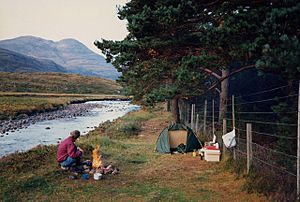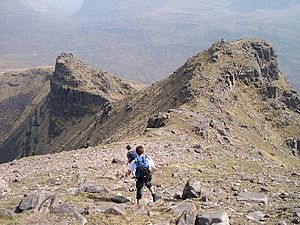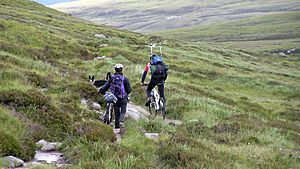Scottish Outdoor Access Code facts for kids
The Scottish Outdoor Access Code is like a rulebook that helps everyone enjoy Scotland's beautiful outdoors. It explains your right to go onto most land and inland water for fun, learning, or just getting around. This right is called "universal access to land" or "freedom to roam," and it became a formal law in 2003 with the Land Reform (Scotland) Act 2003.
The main idea is that everyone shares responsibility. If you're out exploring, you need to act responsibly. And if you own or manage land, you need to respect people's right to access it. The Code gives clear advice on how to do both.
These access rights cover most land, no matter who owns it. You can do non-motorized activities like walking, cycling, horse-riding, and even wild camping. On water, you can canoe, row, sail, and swim. Scotland's access rights are much wider than those in England and Wales.
Both the Scottish Government and the Scottish Parliament have approved the Code. It helps solve most problems about access. If a disagreement goes to court, a judge will check if anyone ignored the Code's advice.
Contents
How We Got These Rights

Most land in Scotland is privately owned, but people have always had a tradition of accessing it. For a long time, this wasn't a problem. But in the mid-1800s, things started to change. More people visited the Highlands, and deer hunting became a big business.
In 1846, the Duke of Atholl tried to stop some university students from entering Glen Tilt. But a court case decided that he couldn't stop them. Later, the Trespass (Scotland) Act 1865 brought in fines for camping or lighting fires without permission. However, people often ignored this law. For many years, there wasn't a clear legal right to access land, but landowners also didn't have a clear way to stop people.
In 1996, groups interested in walking and climbing worked with land managers and the government. They created a voluntary guide called Scotland's Hills and Mountains: A Concordat on Access. This guide talked about responsible access and was an early version of today's Code. But it wasn't a law and didn't cover water access.
Finally, in 2003, the Land Reform (Scotland) Act 2003 made access a formal legal right. This law said that people only have access rights if they use them "responsibly." The law then asked Scottish Natural Heritage to create the Code. This Code helps both people using the land and land managers understand what "responsible" behavior means.
Key Ideas and Responsibilities

The Scottish Outdoor Access Code is built on three main ideas. These apply to everyone, whether you're out exploring or managing land:
- Respect other people's interests.
- Care for the environment.
- Take responsibility for your own actions.
The Code then explains specific responsibilities for different groups.
Your Responsibilities When Using Access Rights
If you're out enjoying the outdoors, you should:
- Be responsible for what you do.
- Respect other people's privacy and peace.
- Help land managers and others work safely.
- Look after the environment.
- Keep your dog under control.
- Be extra careful if you're organizing an event or a business activity.
Responsibilities for Land Managers
If you manage land or water, you should:
- Respect access rights when you manage your land.
- Be fair when you ask people to avoid certain areas for land work.
- Work with your local council and other groups to help access and land management work together.
- Think about access rights if you manage land or water that connects to other areas.
Activities You Can Do

The Code says you can use access rights for fun, some learning activities, certain business purposes, and for traveling across land and water.
Fun Activities
Many outdoor activities are allowed, such as:
- Walking, cycling, horse riding, and carriage driving.
- Rock climbing, hill-walking, running, and orienteering.
- Skiing (touring or mountaineering) and caving.
- Canoeing, kayaking, outdoor swimming, rowing, windsurfing, sailing, and diving.
- Air sports like paragliding.
You can also do less active things like watching wildlife, sightseeing, painting, photography, visiting old sites, walking your dog (if it's controlled), having picnics, playing, sledging, paddling, and flying kites.
Learning and Business Activities
Access rights also cover learning activities, like a teacher taking students outside to study nature or visit a geological site. Doing surveys of natural or historical places is also allowed.
You can use access rights for business activities, but only if the activity could also be done for fun. For example, a mountain guide taking a client out is allowed because anyone could do that activity for fun.
What You Cannot Do
- Motorized Activities: You cannot use motorized vehicles like motorbikes, off-road cars, or powered boats on water. This also includes microlight aircraft, powered models, and drones. However, if you have a disability, you can use a motorized vehicle or boat made for you, like a motorized wheelchair.
- Hunting, Shooting, Fishing: Access rights do not let you hunt, shoot, or fish. You need special permission from the person who owns those rights. You can carry a firearm only if you are crossing land to get to a place where you have shooting rights.
- Commercial Gathering: You cannot gather things like mushrooms or berries to sell them. But picking wild fungi and berries for yourself is usually fine.
- Illegal Acts: Access rights must be used lawfully, so criminal acts are not covered.
Night Access
You can use access rights day or night. But at night, you must be extra careful to respect people's privacy and peace. Stay away from buildings and use paths and tracks when possible.
Wild Camping
Wild camping is allowed under the Code. This means lightweight camping by a small number of people, staying no more than two or three nights in one spot. You can wild camp wherever access rights apply. However, it's best not to camp in enclosed fields and to stay well away from buildings, roads, and historic places.
When wild camping, you must leave no trace. This means taking all your rubbish with you, removing all signs of your tent and any fires, and not causing any pollution.
In 2017, Loch Lomond and the Trossachs National Park brought in special rules for camping around much of Loch Lomond. This was because of problems like litter and bad behavior from some campers. Now, camping in many areas of the park requires a permit between March and October. Groups like Mountaineering Scotland and Ramblers Scotland were against these rules, saying they would make responsible camping illegal.
Where You Can Go
You can use your access rights over most land in Scotland. This includes hills, mountains, moorland, woods, and forests. You can also access fields where crops haven't been planted or where farm animals are grazing. If crops are growing, you can only use the edges of those fields.
Places Not Covered by Access Rights
- Private Gardens: Access rights do not cover the land right around a house or other home (like a static caravan). This is to give residents a reasonable amount of privacy. This usually means the garden area that is actively used by the residents.
* The courts have sometimes had to decide how much land around a home is needed for "reasonable privacy." For example, around Kinfauns Castle, about 14 acres were excluded from access rights.
- Other Buildings: Access rights do not cover the land very close to other buildings like factories, offices, or hotels. This land is usually connected to the building and forms one area with it.
- Urban Areas: Most urban parks and managed open spaces are covered. But places where you usually pay to enter, like gardens or safari parks, are not.
- Sports Areas: You can use grass playing fields and land for sport and recreation, like the fairways of a golf course. But you must not get in the way of the sport being played. Areas specially managed for sport, like golf greens, bowling greens, and cricket squares, are not covered. Neither are sports pitches made of artificial materials.
- Water Access: Access rights cover inland water like rivers, lochs, canals, and reservoirs for swimming and other non-motorized water sports. This also includes riverbanks, loch shores, beaches, and the coastline. However, you cannot drive or park vehicles on the shore just to do water sports.
- Workplaces and Schools: Some workplaces like railways, airfields, airports, quarries, and construction sites are excluded. Land next to schools that the school uses is also excluded.
- Temporary Restrictions: Sometimes, access can be temporarily stopped by the local council for events like a music festival or car rally. Landowners can also temporarily limit access for safety, like banning dogs from a field where sheep are lambing or stopping people walking through an area where trees are being cut down. If this happens, there should be signs explaining why and for how long, and showing an alternative route.
See also
- The Country Code
- Freedom to roam


